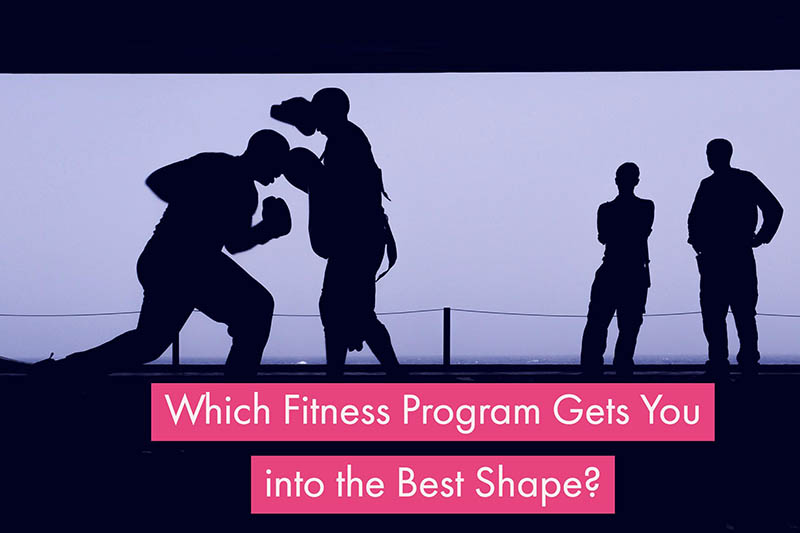When you set your New Year’s resolutions and tell yourself you’ll lose weight or achieve some level of fitness, what strategy do you employ? Looking back on my 2011 fitness goals, I realized I’d unwittingly put myself through 4 different fitness routines, each with varying results. If I break last year into quarters, I can safely say that the first quarter was an experiment with CrossFit, the second with fitness boxing at Cappy’s Gym, the third with P90X, and the last with good ol’ running. Which one got me in the best shape? Well, let’s first define what ‘in shape’ means.
What does “in shape” mean?
My personal fitness goal is simply maintenance with minor strength and endurance improvements. In other words, weight loss is not a primary goal. I should also disclose that I don’t believe in strict schedule regimes. Sure, I dream to have toned abs and killer calves, but that doesn’t beat my desire to eat well and occasionally be at happy hour at 5 pm rather than the gym. With that being said, my experience with fitness programs doesn’t involve strict adherence to any schedules or diets, with the exception of sticking with the Paleo Diet for a month during CrossFit. I tried my best, but 3 times out of 10 I said to hell with the diet and gave in to my Molly Moon cravings (and it was worth it!).

First quarter: CrossFit
Being a fitness enthusiast, I’d heard a lot of positive things from people who have become diehard CrossFitters. In essence, “CrossFit is a methodology that seeks to define what fitness is and how to achieve it. Essentially, combining movements like pushing, pulling, bending, jumping, throwing, swinging, lifting, and running into fast, intense workouts will improve your performance across a broad range of activities.” CrossFit doesn’t promise or even strive to help you lose weight; that is simply a secondary benefit. The primary benefit is to improve your overall form in doing everyday activities and use this is a launching platform to achieve fitness. It seemed convincing enough to me.
What is CrossFit?
I started off by enrolling at Foundation CrossFit in Seattle. Like all other newbies, my first few weeks were spent in required personal training, where I learned proper technique for CrossFit’s Olympic weightlifting standards. Prior to training, I had only a vague idea of what deadlifts or wall balls were. By the end of the month, I knew these exercises a little too well.
After completing CrossFit boot camp, you sign up for a monthly membership that allows you to enroll in CrossFit classes. You pay more depending on how frequently you want to attend class. Either way, most CrossFit boxes (lingo for ‘gym’) will often post their Workout of the Day (WOD), which is designed to be completed in 30 minutes or less, adding the selling point of CrossFit being a quick yet comprehensive workout. You’re never mandated to do a daily workout, but the more you do, the more fit you become.
What’s Great About CrossFit
I loved how supportive the CrossFit community was, both online and offline. Most boxes offer daily classes that are kept small in number, allowing for more personal coaching throughout the workouts and leaving you more motivated to keep coming back. If that isn’t enough motivation, all you need is to flip through a CrossFit blog to get you fired up. For the dedicated, CrossFit truly becomes a lifestyle. For those who love encouragement, motivation, and competition, CrossFit is perfect. I definitely exercised muscles I never knew existed, and actually had a lot of fun during workouts. Who knew that dragging a large tire around could be a workout?
CrossFit Results
After three months of CrossFit WODs, coupled with a semi-strict adherence to the Paleo Diet, I got into my peak fitness point of the year. I lost weight without intending to and was physically stronger than ever. Never before had I been able to complete 10 unassisted pull-ups. By the time the third month rolled around, I was craving endurance workouts. As a distance runner accustomed to 2-hour workouts on the road or treadmill, the 30-minute WODs rarely satiated my energy levels. I never got used to the idea that 30 minutes of Olympic lifting and short to medium distance sprints could be comprehensive workouts. Not to mention, the monthly price tag was killing me. Compared to paying for a monthly gym membership, CrossFit is pretty expensive. Next, I moved on to a more cardio-intensive workout.

Second quarter: Boxing Fitness
For this experiment, I opted to enroll at an actual boxing studio, rather than my chain gym’s boxing class. I opted for Cappy’s Gym in Seattle. By far the hardest part was building up the courage to walk through the front door. I was intimidated by the thought of being surrounded by beefy guys looking for their next victim to pummel. It turned out that the vibe at Cappy’s is the exact opposite. Locally-owned, the staff at Cappy’s is limited to several skilled, friendly coaches who learn your name faster than your high school English teacher would. As for the gym members, they include men and women from all walks of life. There were a few muscled guys who you could tell were more serious about boxing, but most people in the boxing fitness class (different from the boxing lessons) were your average gym goers looking for a good workout.
What’s a boxing fitness class like?
To get started at Cappy’s, all you need to do is fill out a waiver, pay $5 for your first introductory class, and get your hands wrapped. There are no special skills needed. All you have to be able to do is have a desire to learn and get sweaty. Even when the boxing gloves come on, you will never be expected to throw a direct punch at a person or take one yourself. Punches are limited to the bags, and it turns out to be a great way to relieve stress.
The hour long boxing fitness class always begins with a jump rope warm up before progressing on to intensive circuit training. You get paired up with a classmate and begin rotating through a bunch of stations set up around the gym floor. Exercises range from basic pushups and box jumps to the more technique-oriented speed bag and shadow boxing. Whatever the exercise, the coach leading the session circulates the room and gives you a quick tip or lesson if needed. You’re guaranteed to work up a sweat and be out of breath within minutes of the class starting. The nice part is that it’s all self-paced, so you push yourself to work as hard as you’re capable of.
Boxing Fitness Results
At the end of three months, I ended up gaining back the weight I had lost during CrossFit, but I blame that on my lack of a diet, rather than the workouts. Boxing fitness classes pack a punch (pun intended) that will whip you in shape at your own pace. Each class has varied exercises, which is great for keeping you physically and mentally challenged. The classes aren’t structured as a program guaranteeing to deliver particular results. This could impact member commitment but also serves as a great overall fitness routine for the self-disciplined. However, at $23/class, it can be costly in the long run. Cost is ultimately what prompted me to look for other fitness alternatives.

Third quarter: P90X 90-Day Extreme Home Fitness
I’ve never been a champion of home fitness programs, especially ones that have their own infomercials. The idea of sweating where I sleep to profit some wacko fitness idea sounds less than ideal. However, P90X generated so much buzz last year, my curiosity got the best of me. P90X is Tony Horton’s home fitness program that promises to get you ripped and in shape in 3 months. This is the strategy of P90X as defined by Wikipedia: “P90X emphasizes ‘muscle confusion,’ a method of cross-training and periodization achieved through switching the order of exercises and incorporating new and varied movements. Muscle confusion supposedly prevents the body from adapting to exercises over time, resulting in continual improvement without plateaus.” Cross training and constantly varied exercises—sounds a lot like CrossFit, doesn’t it? That’s certainly what I thought until I embarked on the P90X challenge.
What is P90X?
Unlike CrossFit and boxing fitness, P90X is highly structured. It has detailed daily workouts and diet plans. After all, you have a major goal to achieve, and only 90 days to do it. This is a “get fit fast” approach, although, with the muscle confusion aspect, you can supposedly use variations of the workouts to stay fit after the 90 days are up. Each workout day of P90X is dedicated to a particular body area. You use your own body weight, resistance bands, and a few dumbbells, so there’s no need for a huge investment in equipment. Specific exercises include variations of traditional gym exercises like pushups, pull-ups, and squats, yoga poses, and even boxing moves. This is where P90X greatly varies from CrossFit. P90X gives you several variations of one particular exercise, while CrossFit throws in tons of movements you never even knew were exercises.
P90X Results
I ended up gaining the most weight from the full P90X program. This was probably due to the extreme muscle-building exercises that did their job and the protein shakes I started consuming. I’m the type that loses weight (and muscle) when I stop working out, so it made sense that P90X, being the most strength-oriented, resulted in a weight gain. By far the worst part about P90X was having to endure Tony Horton’s workout videos. While I can confirm his program works, Horton’s overly gung-ho personality kills. Maybe the strategy is to have him annoy you so much that you work harder in the process. I don’t know, but I could do without his over the top enthusiasm and commentary. Other than that, if you’re looking for a solid, detailed fitness plan and a set time frame to do it, P90X is an affordable and effective alternative.

Fourth quarter: Running
After investing in 9 months of fitness programs, I decided to give my wallet a rest. I was also craving workouts where I could plug in my headphones and not have to pay attention to an instructor. My fitness routine focused on the basics of outdoor endurance runs with several days a week of strength training. To help with motivation, I also re-read Haruki Murakami’s memoir What I Talk About When I Talk About Running, which rekindled my love for the sport.
I qucikly realized it was possible to borrow from each program I had participated in. I still had my P90X workout videos that I could reference for guidance and the CrossFit main website posts Workouts of the Day (WODs). There was more than enough variation to draw from. By switching up the days and the endless combinations of workouts, it seemed like a win-win fitness solution that’s practically free.
Sample Cross Training Workout Program
- Sunday: long endurance run
- Monday: outdoor CrossFit WOD circuit (5x400m run, 20 bleacher jumps, 20 pushups, 20 squats, 20 chair dips)
- Tuesday: endurance run
- Wednesday: P90X weights session (variations of pull-ups, pushups, squats, bicep curls, etc)
- Thursday: endurance run
- Friday: boxing fitness fun (jump rope, shadow boxing/P90X kempo routine)
- Saturday: rest day
In Conclusion
So which of the four fitness programs was the best? Well, CrossFit is great for learning you can push yourself beyond all boundaries. Think you can’t do an unassisted pull-up and want to learn how? Go to CrossFit. If you’re looking for general cardiovascular and endurance training that involves boxing moves, check out a boxing fitness class. You might enjoy it so much you’ll dare to get into real boxing. If you have targeted fitness goals that you want to achieve without going to the gym, give p90X a shot. It’s also the most affordable of the aforementioned programs. Finally, if you love endurance sports or want to stick to basics, go for a walk or run. Just getting outside on a daily basis will do you good.
The abundance of fitness options is great for exploring different workouts, both with and without a gym. It’s hard to say which workout philosophies will actually endure for me personally, and for the fitness community in general. I mean, who knows? Maybe the Shake Weight is really a fitness revolution after all. You don’t know until you try it.
Suzi Pratt is a Seattle event, food, and travel photographer available for hire. She is also a contributing writer at Digital Photography School and runs a blog teaching others how to start a photography business.




